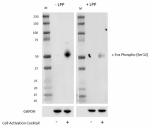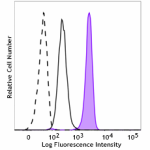- Clone
- A22009C (See other available formats)
- Regulatory Status
- RUO
- Other Names
- G0S7, p55, cFos, c-Fos, Proto-oncogene, Transcription Factor subunit, AP-1
- Isotype
- Mouse IgG2b, κ

-

IHC staining with Alexa Fluor® 647 anti-c-Fos Phospho (Ser32) was performed on formalin-fixed paraffin-embedded human brain cortex following antigen retrieval using Citrate buffer (Cat. No. 420902). The tissue sections were incubated with Alexa Fluor® 647 secondary antibody only (panel A) or with Alexa Fluor® 647 anti-c-Fos Phospho (Ser32) (clone A22009C) (panel B). Nuclei were counterstained with DAPI (Cat. No. 422801). -

HeLa cells untreated or treated with Cell Activation Cocktail (without Brefeldin A) (Cat. No. 423301) were fixed and permeabilized with 2% PFA and ice-cold methanol, and then intracellularly stained with Alexa Fluor® 647 anti-c-Fos Phospho (Ser32) (clone A22009C) (Red) or with Alexa Fluor® 647 mouse IgG2b, κ isotype control (Cat. No. 400330). Nuclei were counterstained with DAPI (Cat. No. 422801) (blue) and Alexa Fluor® 488 anti-Cytokeratin (clone C-11) (Cat. No. 628608) (green). Scale bar 50 µm
| Cat # | Size | Price | Quantity Check Availability | ||
|---|---|---|---|---|---|
| 631259 | 25 µg | $190.00 | |||
The proto-oncogene c-Fos is the human homolog of the retroviral v-Fos oncogene, and is a member of the Fos family of transcription factors. c-Fos forms heterodimers with proteins of the Jun family of transcription factors to form the Activator Protein-1 complex (AP-1). This complex is involved in critical cellular processes such as inflammation, cell proliferation, differentiation, survival, hypoxia, bone development and angiogenesis which suggests c-Fos is an important therapeutic target for cancer, vascular remodeling, acute inflammation and autoimmune diseases. In addition, increases in c-Fos expression and activation are associated with neuronal activity induced by psychoactive drugs. Expression of c-Fos is rapid and transitory, and phosphorylation at residues Ser32 and Thr232 by Erk5 increases protein stability and nuclear localization.
Product Details
- Verified Reactivity
- Human
- Antibody Type
- Monoclonal
- Host Species
- Mouse
- Immunogen
- Synthetic peptide from human c-Fos phosphorylated at Ser32.
- Formulation
- Phosphate-buffered solution, pH 7.2, containing 0.09% sodium azide
- Preparation
- The antibody was purified by affinity chromatography and conjugated with Alexa Fluor® 647 under optimal conditions.
- Concentration
- 0.5 mg/mL
- Storage & Handling
- The antibody solution should be stored undiluted between 2°C and 8°C, and protected from prolonged exposure to light. Do not freeze.
- Application
-
IHC-P - Quality tested
ICC - Verified - Recommended Usage
-
Each lot of this antibody is quality control tested by formalin-fixed paraffin-embedded immunohistochemical staining. For immunohistochemistry, a concentration range of 5.0 - 10.0 µg/mL is suggested. For immunocytochemistry, a concentration range of 5.0 - 10.0 μg/mL is recommended. It is recommended that the reagent be titrated for optimal performance for each application.
* Alexa Fluor® 647 has a maximum emission of 668 nm when it is excited at 633 nm / 635 nm.
Alexa Fluor® and Pacific Blue™ are trademarks of Life Technologies Corporation.
View full statement regarding label licenses - Excitation Laser
-
Red Laser (633 nm)
- Application Notes
-
We recommend this antibody for use in immunocytochemistry (ICC) and immunohistochemistry on formalin-fixed paraffin embedded tissues (IHC-P).
For use in intracellular staining flow cytometry (ICFC), we recommend Cat. Nos. 631257 and 631258. This antibody is the same clone developed with optimal F/P ratio for flow cytometry. - RRID
-
AB_3662404 (BioLegend Cat. No. 631259)
Antigen Details
- Structure
- c-Fos is a 380 amino acid length protein. It has a leucine zipper domain that allows it to form heterodimers with members of the Jun family proteins.
- Distribution
-
Non-phosphorylated forms can be found in the endoplasmic reticulum. However, after activation/phosphorylation the protein is translocated to the nucleus.
- Function
- c-Fos is a subunit of the AP-1 transcription factor. The half-life of the protein is short; however, phosphorylation induces protein stability and translocation to the nucleus.
- Interaction
- c-Fos interacts with members of the Jun family proteins to form the AP-1 transcription factor.
- Ligand/Receptor
- As a part of the transcription factor AP-1, it binds to specific DNA sequences to regulate gene transcription
- Biology Area
- Cell Biology, Cell Proliferation and Viability, Immuno-Oncology, Immunology, Innate Immunity, Neuroscience, Transcription Factors
- Molecular Family
- Innate Immune Signaling, Phospho-Proteins, Tumor Suppressors
- Antigen References
-
- Sasaki T, et al. 2006. Mol Cell. 24:63-75.
- Huang K, et al. 2014. Cell Signal. 26:629-38.
- Qu X, et al. 2019. Cancer Sci. 110:3183-3196.
- Guo JC, et al. 2015. PLoS One. 10:e0120332.
- Rodriguez-Berdini L, et al. 2020. J Biol Chem. 295:8808-8818.
- Gene ID
- 2353 View all products for this Gene ID
- UniProt
- View information about c-Fos on UniProt.org
Other Formats
View All c-Fos Phospho Reagents Request Custom Conjugation| Description | Clone | Applications |
|---|---|---|
| Purified anti-c-Fos Phospho (Ser32) | A22009C | WB,ICC,ICFC |
| PE anti-c-Fos Phospho (Ser32) | A22009C | ICFC |
| Alexa Fluor® 488 anti-c-Fos Phospho (Ser32) | A22009C | ICFC |
| Alexa Fluor® 647 anti-c-Fos Phospho (Ser32) (for Flow Cytometry) | A22009C | ICFC |
| Alexa Fluor® 647 anti-c-Fos Phospho (Ser32) (for IHC and ICC) | A22009C | IHC-P,ICC |
Compare Data Across All Formats
This data display is provided for general comparisons between formats.
Your actual data may vary due to variations in samples, target cells, instruments and their settings, staining conditions, and other factors.
If you need assistance with selecting the best format contact our expert technical support team.
-
Purified anti-c-Fos Phospho (Ser32)

Whole cell extracts (15 µg total protein) from HeLa cells un... 
HeLa cells untreated (top panels), or treated with Cell Acti... 
HeLa cells untreated (negative control, open histogram), or ... 
IHC staining of Purified anti-c-Fos Phospho (Ser32) on forma... -
PE anti-c-Fos Phospho (Ser32)

HeLa cells untreated (negative control, open histogram), or ... 
HeLa cells treated with Cell Activation Cocktail (without Br... -
Alexa Fluor® 488 anti-c-Fos Phospho (Ser32)

HeLa cells untreated (negative control, open histogram), or ... 
HeLa cells treated with Cell Activation Cocktail (without Br... -
Alexa Fluor® 647 anti-c-Fos Phospho (Ser32) (for Flow Cytometry)

HeLa cells untreated (negative control, open histogram), or ... -
Alexa Fluor® 647 anti-c-Fos Phospho (Ser32) (for IHC and ICC)

IHC staining with Alexa Fluor® 647 anti-c-Fos Phospho (Ser32... 
HeLa cells untreated or treated with Cell Activation Cocktai...
